Posts
-
Let's Read the 4e Monster Manual 2: Gnolls
The absolutely best thing about the Monster Manual 2 gnolls is that I don’t have to talk about them! It turns out I’ve already covered them all in the MM1/Monster Vault gnoll post. The Deathpledged Gnoll, Fang of Yeenoghu, and Gnoll Gorger that appeared in the Monster Vault all had their first appearances here in the MM2. Just read the original article for everything you need to know about 4e gnolls.
-
Let's Read the 4e Monster Manual 2: Giants
The first Monster Manual and the Monster Vault contained plenty of giants, whose lore in 4e is pretty awesome. I covered their basic lore here, and also had individual posts for hill, frost, fire, death and storm giants.
The Monster Manual 2 added more giants, and it’s actually where Frost Giants made their first appearance in this edition. We already covered them in the corresponding post linked above. In this one, we’ll cover the two other varieties introduced in the same entry: Eldritch and Stone giants. The latter are old standbys, and I had never heard of the former until now. If they existed in a previous edition, it was in one of the more out-of-the-way supplements or Dragon articles for 3e.
Eldritch Giants
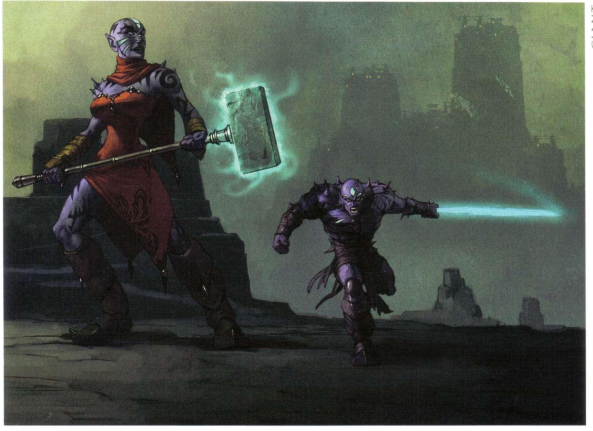
Copyright 2009 Wizards of the Coast As mentioned in the basic lore post, the primordials made the first Giants from the same elements they used in the world, to help them shape and understand it. Well, it turns out raw magic is as much a basic building block of the world as the more classical elements of earth, fire, air, and water. Therefore, it got its own Giant type.
Eldritch giants were among the most powerful creations of the Primordials, and they helped a lot with shaping the flow of magical energies in the still-cooling world. Today their power is much diminished from what it was at the dawn of time, and most of them dedicate their lives to accumulating magical power and knowledge in hopes of returning to those lofty heights.
Both eldritch giants and titans are still well-versed in magic. They know how to form weapons out of pure force, and they tattoo their bodies with symbols that allow them to absorb the magic of others and teleport at will. They live near sources of arcane power, and jealously hoard knowledge and artifacts. Eldritch giant social hierarchy is based on how much power individuals managed to accumulate - Eldritch Titans tend to be at the top. An individual eldritch giant or titan might have more abilities than what is depicted in the “typical” stat blocks of this entry, and they’ll certainly have access to lots and lots of magic rituals.
Most interactions between mortals and eldritch giants as written here are likely to be hostile, since the giants don’t have much reason to be friendly. They love binding and enslaving other creatures with magic, though, so they might be encountered alongside powerful elementals, slaads, and other such creatures. A more reasonable group of them would make valuable allies against powerful incorporeal enemies, though, since they specialize in force magic.
Eldritch Giant
“Standard” eldritch giants are Large Fey Humanoids with the “giant” keyword, and Level 18 Skirmishers with 171 HP. They have low-light vision, 10 force resistance, and a +5 bonus to saves vs. charm effects. Their ground speed is 8 and they also have a teleport speed of 6.
These giants fight in melee with Reach 2 Eldritch Blades that target Reflex and deal force damage, and at range with Range 20 Force Missiles that do the same. Being so large, they can also use Sweeping Sword attacks to target everyone in a Close Blast 2 instead of a single victim, and they can do that even when charging.
As a minor action, they can deploy an Eldritch Field (close blast 5; recharge 5+) that counts as difficult terrain and makes enemies inside take extra damage from the their attacks. Also as a minor action, they can use Consume Magic to absorb a magic zone created by a PC. This requires them to hit the caster’s Will with an attack, and if they succeed their own attacks get a big damage boost until the end of their next turn.
Eldritch Titan
Eldritch Titans are Huge, and Level 21 Elite Skirmishers with 394 HP. They have the same passive traits as their smaller cousins.
Their Reach 3 Eldritch Hammers deal more damage, and they can make two attacks per action, even on a charge. Their ranged force attack is also stronger and pushes the target 5 squares on a hit.
Once per encounter they can cast a Force Hammer that damages everyone on a close blast 3, pushes then 3 squares and knocks them prone. On a miss the targets still take half damage and are pushed. They have the same Consume Magic and Eldritch Field abilities as eldritch giants.
Stone Giants
The other type of classic earth giant, Stone Giants are among the most reasonable people among all giantkind. They usually don’t care about raiding or conquest, and just want to be left alone in their mountain homes. Discrete and contemplative sorts, they can stay immobile for years while lost in thought, and are surprisingly adept at hiding themselves in their home terrain.
Someone passing throug stone giant territory might never spot them at all, and ill-intentioned travelers might find themselves ambushed before they can do any harm. The exception to all of this is when the giants are feeling rowdy and want to have some fun: their favorite game is basically dodgeball with enormous boulders, and when they’re in the middle of it they don’t usually pay attention to any smaller creatures who might be in the path of those boulders.
Stone giants are one of the few Giants who are actually on friendly terms with communities of galeb duhrs and azers. They have a long and proud tradition of stone carving, and their magic is based on carved runes. It’s possible the dwarves originally learned their own rune-magic from stone giants, though modern dwarf scholars dispute this notion.
Friendly giants of other types, unable to stand their generally unpleasant societies, often move in with stone giants. Conversely, evil stone giants tend to move out of their ancestral homes and throw their lot with their more villainous relatives.
Stone Giant
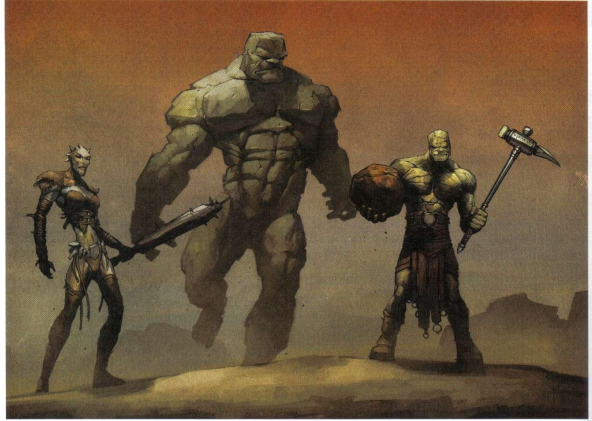
Copyright 2009 Wizards of the Coast Stone Giants are Large Elemental Humanoids with the Earth and Giant keywords. They’re Level 14 Soldiers with 140 HP, immune to petrification, and have a ground speed of 8 with Earth Walk. This lets them ignore difficult terrain with a “geological” origin.
They use giant-sized stone greatclubs. As usual for soldiers, their basic attacks mark on a hit and they can make opportunity attacks marked creatures in reach that move or shift. They can also make a Staggering Sweep that works like an area attack, pushes targets 2 squares, and marks them. At range, they can hurl rocks like you’d expect out of an old-school giant.
While they’re unbloodied, they can use Stone Bones as an interrupt when hit by an attack, gaining 5 resistance do its damage.
Stone Giant Runecarver
This spellcaster is a Level 16 Controller with 155 HP and the Leader keyword. Their magic is partly about slowing and immobilizing enemies, and partly about doing unpleasant things to enemies suffering from those conditions.
They fight in melee with Enruned Picks, which are High-Crit weapons and have a slow (save ends) rider. Grasping Stone ensures that any enemy slowed by the giant is also immobilized for a turn.
Magic-wise, their Rune of Thundering Echo (recharge 5+) deals thunder damage over an area and inflicts ongoing thunder damage (save ends) on targets who are slowed or immobilized. The Rune of Stony Sleep (recharge 6+) affects a similar area, deals physical damage and slows (save ends). After the first failed save, slowed enemies become petrified instead (save still ends). That rune also creates a zone within its affected area that inflicts a -2 penalty against saves vs. slowness or immobilization effects.
“Save ends” petrification might not sound so bad, but runecarvers also have a Hardened Focus aura (5) that makes all petrified enemies inside lose any damage resistance they have and gain Vulnerable 5 to all damage. An evil runecarver is a good counter to a group of PCs who thought a fight against frost or fire giants was going to be easy just because they packed the right elemental resistances.
Stone Titan
Stone Titans are basically Stone Giants Plus, being Huge in size and Level 18 Elite Soldiers with 348 HP. They fight unarmed and throw rocks, but there are some important differences.
First, their marking ability is a Slipstone Distortion aura (1) that marks any enemy who starts their turn inside. Their slams deal extra damage to marked enemies, and they can make opportunity attacks against marked enemies like stone giants can.
Second, they can use an Avalanche Stomp (encounter) to attack everyone in a Close Burst 3, with a hit doing heavy damage and causing the very earth to grab the targets. The escape DC is 28, and the giant doesn’t need to spend actions to sustain the grab. A miss still does half damage.
And third, they can “charge” a thrown rock and turn it into a Quakestone (recharge 5+), making it into an area attack that does light damage, knocks prone, and dazes (save ends) on a hit. A miss does half damage and knocks prone without the daze.
Final Impressions
Eldritch giants have a somewhat unusual name and appearance when compared to the traditional types, but they’re a lot closer to them than it seems at first. I guess calling them “Force Giants” would have been a little too on the nose, but this is basically what they are. They use Force attacks in the same way a frost giant would use Cold, or a fire giant would use Fire. Their fighting style is similar, aside from the “I eat magic!” thing.
Stone giants on the other hand are one of the traditional types that have been there since the beginning. I’m happy to see them here because your average stone giant fits the “Earth Giant” mold a lot more readily than a hill giant, who’s just a big human-looking person. I also like that the book doesn’t consider all of them evil, and even mentioned that they partner up with non-evil individuals of the other giant types. I often ponder how to make sapient monsters less evil and hostile when I discuss them, so it’s nice to see an entry that does that as written.
-
Let's Read the 4e Monster Manual 2: Ghost Legionnaire
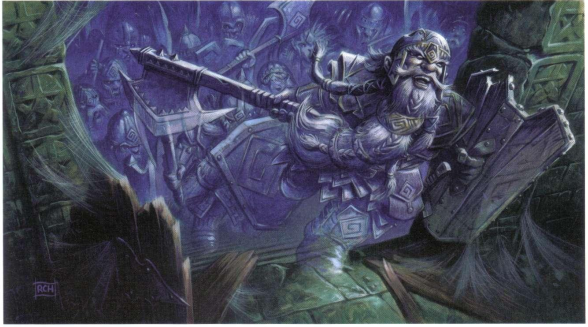
Copyright 2009 Wizards of the Coast The first Monster Manual already includes a bunch of ghosts, and it even has a basic Phantom Warrior. Here we have a more specific implementation of that concept.
The Lore
These creatures are the ghosts of soldiers who died in battle more or less at the same time as the entire rest of their units. The emotional bonds between them and the trauma of their violent massed deaths causes their spirits to fuse and to rise as undead.
Legionnaires always appear as a unit, and they look like individuals acting in concert, but they’re all part of the same collective ghost. So it might have been more accurate to title this entry “Ghost Legion”. Members of the legion can possess the living and make them experience the soldiers’ last moments.
When a ghost legionnaire is damaged, it always displays the wounds it suffered in its final battle rather than the ones that were actually inflicted on it. So a squad killed by some wizard’s acid-infused fireball would grow progressively more burned and melted as the PC paladin stabs them.
A ghost legion might be endlessly reliving its last battle when found, seeing any living intruders as their enemies. It might also be following the orders of a more powerful undead being, particularly if that being was one of its commanders in life.
The Numbers
An individual legionnaire is a Medium Natural Humanoid with the Undead keyword, and a Level 13 Soldier with 100 HP. Despite being a ghost, it’s not considered insubstantial, but it has 10 necrotic resistance and isn’t especially vulnerable to radiant damage.
Legionnaires fight with the same weapons they had in life, making devastating cuts with their melee weapons or shooting ghost arrows that do necrotic damage. They can also use their Battle Visions power to possess a target. This has range 20, targets Will and deals psychic damage with a Dominate (save ends) rider. While the target is dominated, the ghost is removed from the map. When the target finally makes their save, the ghost reappears in an adjacent space.
This ghost’s main weakness takes the form of a trait named Call to History. It allows a PC to make a DC 25 History check as a minor action to recall details about the legionnaire’s original unit. A success here makes the PC’s next attack against that ghost deal 10 extra damage. I don’t think you can stack multiple checks in a single attack, but you can make a check every turn before you attack. Someone who was possessed and made their save has a +5 bonus to these tests for the rest of the fight, as those horrifying battle visions act as extra reference material.
The collective nature of a ghost legion is expressed by the Soul Link trait. Basically, you combine the HP totals of all legionnaires present in the fight into a single pool. Damage to any individual legionnaire is subtracted from this combined pool. The whole unit is destroyed when this pool is reduced to 0, but until that happens all legionnaires remain in the fight! This makes the usual “focus fire” strategy considerably less effective against them.
Sample Encounters and Final Impressions
The sample encounter is Level 15, and quite straightforward: a 5-ghost unit and a human lich wizard from the MM. A Nerathi squad plus their former commanding officer.
I really like the “collective HP” gimmick! It shouldn’t be too hard to add or subtract levels from the stat block given here, either, meaning you can bring the Fun (TM) of ghost legions to the party no matter what their level.
There isn’t much of a story difference between a ghost legionnaire and a phantom warrior, as you can see by their names. This suggests that one way to get a level 4 legionnaire would be to remove Insubstantial from the warrior and add Soul Link in its place. You can likely do the same with any other thesaurus buddies that might come along (banshee battlers, figment fighters, spectral soldiers, wraith warriors…).
-
Let's Read the 4e Monster Manual 2: Genasi

Copyright 2009 Wizards of the Coast The concept of “people touched by the elements” is a 3e thing, but genasi as presented in Fourth Edition are slightly different than what came before them. They debuted in the Forgotten Realm Player’s Guide as a playable option, and would later appear in the MM2 in “monster” format.
The Lore
In previous editions genasi were humans with “genie blood”, but in Fourth they’re simply humanoid sapients from the Elemental Chaos. They’re given no cosmically significant origin story like tieflings or daeva, so I must assume they simply evolved naturally in that plane.
Genasi look more or less human and have human proportions, but each of them also has an elemental manifestation. The five known manifestations are “firesoul”, “watersoul”, “windsoul”, “stormsoul”, and “earthsoul”. Each genasi is born with one of these and an individual’s manifestation has more to do with their environment than with genetics. A genasi community built inside a volcano is going to have a lot of firesouls, and so on.
A genasi’s manifestation accents their physical appearance and defines some of their inborn powers and resistances. It’s an always active part of their being, not something they can turn off. Some of them train to acquire additional manifestations. PCs can have two at most, but some NPCs can have more.
Genasi live primarily in the Elemental Chaos. They have an easier time of it than most other mortals but still must step lightly around efreeti and the like. They can also be found in the world or in the Feywild, since they don’t have any more difficulty living there than a human would.
The Numbers
Genasi are Medium Elemental Humanoids, with a ground speed of 6. They tend to have keywords corresponding to their elemental manifestations: a fire genasi will have the Fire keyword, and so on. Their manifestation also determines what elements they are resistant to, if any, and the themes of their powers. What those powers are is mostly a function of training, so varies per stat block.
Genasi Elemental Dervish
“I’m the Avatar, and you’re gonna have to deal with it!” This is a genasi warrior who has learned to manifest multiple elements, and trained extensively with the double sword. They can move equally well on the ground, in the water, or in the air. Their sword attacks can cause several different types of elemental damage, as can their magic.
Elemental dervishes are Level 18 Elite Controllers with 344 HP and keywords for the four “classic” elements (air, earth, fire, water). They have ground, swim, and fly speeds of 6, and 10 resistance to cold, fire, and lightning damage.
At the start of its turn, the Dervish chooses an between fire, lightning and thunder. Their double sword attacks will deal both immediate and ongoing damage of that type. They can make two of those per action, being elites.
When a dervish is hit by an adjacent enemy, it can use its reaction to respond with a Fiery Riposte, which targets Reflex and inflicts 10 ongoing fire damage (save ends). If the enemy was already on fire, their existing ongoing fire damage increases by 10 instead.
Their special attack is Primordial Storm (recharge 5+), which allows them to shift 6 squares and perform three attacks in order against different targets at any point along the movement. The first is Promise of Storm, which deals thunder damage and makes the target Vulnerable 5 to thunder (save ends). The second is Earth Shock, which deals physical damage and stuns for a turn. The third and last one is Lightning Cut, which deals lightning damage and inflicts 10 ongoing lightning damage.
The elemental dervish is flashy and awesome, and given enough time or well-selected comrades they can set up some interesting elemental damage combos.
Genasi Fireblade
A very straightfoward hot-headed warrior who charges into combat with a flaming falchion. It’s a Level 11 Brute with 139 HP.
The falchion it wields is a High-Crit weapon and inflicts ongoing fire damage. It has the same Fiery Riposte as the dervish, dealing 5 ongoing damage instead of 10. Its other power is Fan The Flames (Close Burst 1 vs. Reflex; recharge 5+), which sets people on fire and gives them a -2 penalty to saves against ongoing fire damage.
Fireblades are going to charge into combat, Fan the Flames, and then get to work on cutting people up and setting them on fire at the same time.
Genasy Hydromancer
AKA, a waterbender that’s also partially made of water. This Level 8 Controller has 91 HP, a swim speed of 8, and fights with a high-crit Scimitar and lots of water powers.
The basic Wave Bolt (ranged 5) deals physical damage and slides targets 3 squares; Whirling Vortex (recharge 5+) does the same in a burst around the hydromancer that affects only enemies; Drowning Touch inflicts ongoing damage on a single target (save ends), but only recharges once the target saves or drops to 0 HP.
The “partially made of water” bit is expressed by two other abilities: Liquid Body is a reaction that allows them to take half damage from the triggering attack, and Swift Current (encounter) allows them to shift their speed with the ability to move through enemy spaces and basically ignore all terrain effects while doing so.
Genasi Skyspy
A windsoul genasi that fights with paired shortswords and uses their mobility powers to enhance their hit and run tactics. They’re a Level 7 Skirmisher with 78 HP and 5 cold resistance.
Their basic short sword attack allows them to shift 1 square on a hit, and they can make two of those against an opponent granting them combat advantage. Feather-Footed gives them an AC bonus against opportunity attacks, and Sky Jaunt (recharge 4+) allows them to fly until the end of their current turn.
Should the PCs manage to surround the skyspy, the genasi can use Manifest Whirlwind (close burst 2; encounter) to do some damage, push them 1 square, and knock them prone. This should help clear some space.
Genasi Stoneshield
A heavily armored earthsoul warrior wielding a heavy pick in battle. It’s a Level 10 Soldier with 106 HP. Stoneshields are difficult to push around - any forced movement applied to them is reduced by 1 square.
The war pick is a High Crit weapon, and it also marks on a hit. This mark is remarkable for being (save ends) instead of only lasting a turn. Marked targets take a -5 penalty to damage against the stoneshield’s allies. They can also attack with a Mighty Bull Rush that does the same damage as the pick and pushes the target 1 square. It also allows the stoneshield to move into the target’s previous position.
Finally, they can stomp really hard and cause a non-damaging Earth Shock (minor action; encounter) that covers a Close Burst 2 and knocks enemies prone on a hit.
Sample Encounters and Final Impressions
Genasi can be found alongside a large variety of other creatures, particularly elementals. They’re as morally varied as humans, so a villain could certainly employ genasi henchpeople. We have three example encounters here:
-
Level 8: 3 genasi skyspies riding hipogriff dreadmounts, accompanied by their pet shardstorm vortex elemental.
-
Level 10: 2 fireblades, 2 stoneshields, and a trained magma strider.
-
Level 19: Two storm archons (a squallshield and a tempest weaver) and two elemental dervish mercs.
Reading about genasi doesn’t give me the sort of instant adventure inspiration that some of the other monsters do, but I like that they exist. Their presence in the Elemental Chaos gives you an excuse to place “normal everyday communities” in that plane for your PCs to interact with. Not every EC settlement is a githzerai monastery or the City of Brass.
-
-
Let's Read the 4e Monster Manual 2: Fomorian
Fomorians first appeared in the first Monster Manual, and we covered them here. This entry gives us more fomorian stat blocks, and a few more bits of lore.
First, we have a bit of general lore, which is really a logical extension of the fact that Fomorians believe themselves the most important creatures in the universe. They hate all other fey, but that hate manifests as a desire to subjugate rather than exterminate them. Their perfect world is one where fomorians rule absolute over the Feywild and have all its other inhabitants forever toiling to please their masters.
Because of this obsession, fomorians are eternally at war with the other fey civilizations. It’s likely they’ll never succeed in conquering all of the Feywild, but they’ll never stop trying either. I suppose there must also be some level of internecine strife among them, because it seems to be they’re very likely to fight over who gets to be supreme ruler.
The remaining bits of lore concern the individual stat blocks here, and so will be covered in those stat blocks.
Numbers-wise, fomorians still retain their common traits from the first article: they’re Huge Fey Humanoids with the Giant keyword; they’re extremely perceptive (trained Perception, Truesight 6); and they have some sort of “evil eye” ability that varies per stat block.
Fomorian Ghost Shaman

Copyright 2009 Wizards of the Coast Ghost shamans are necromancers who enslave the spirits of those they kill. They command these spirits as if they were puppets, enacting sadistic plays for their own amusement. They also use enslaved spirits as weapons in combat.
Ghost shamans are Level 16 Elite Controllers with 312 HP. They have darkvision in addition to the other fomorian traits. All of their attacks are magical in nature and, except for the Evil Eye, target Fortitude. Their basic melee attack is Death’s Touch, which deals necrotic damage and slows (save ends). Their Evil Eye is a minor-action ranged attack that inflicts ongoing necrotic damage (save ends).
At will, they can use Spirits of Possession (close blast 3), which targets people taking ongoing necrotic damage and dominates them on a hit (save ends). A bit less often they can use Darksoul Mist, which is like a necrotic fireball that leaves a zone of darkness in the affected area. This blocks line of sight for anyone without darkvision.
Fomorian Cackler

Copyright 2009 Wizards of the Coast Cacklers are sly but unhinged assassins who get their name because they constantly laugh a disturbing laugh. They can be silent when they want to be, though, and are amazingly stealthy for someone the size of a house. They can also use magic to shrink down to Medium size, which helps a lot.
Cacklers are also excellent at disguising themselves, since their minds can easily construct entire fake personalities to aid in that. It’s possible for previously discarded personalities to momentarily come to the fore again, though, which is part of why they’re so unstable.
They fight with daggers bigger than the average human greatsword, which they can use in melee or throw out to range 10. The thrown dagger attack can target one or two enemies, and they return after it resolves.
Their Evil Eye makes them invisible to the affected enemy, and they get a big bonus to damage against targets that can’t see them. Size Alteration lets them switch between Huge and Medium as a minor action.
Fomorian Totemist
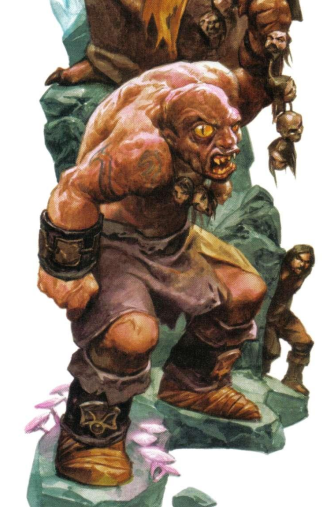
Copyright 2009 Wizards of the Coast Totemists are fomorian spellcasters that collect the heads of those they kill and build chains out of them. Each head in the chain is imbued with necromantic power, and can channel a different curse. Most totemists have a preference for a particular type of head - one might favor eladrin heads, another dwarves, and so on. Some of them select prospective additions to their chains year in advance, following the lives of their future victims until the time is right for the “harvest”.
Totemists are Level 18 Elite Skirmishers with 352 HP. They fight with the afore-mentioned Chain of Heads, which is Reach 4, does physical damage and inflicts ongoing necrotic damage. They can also channel curses through the chain as a minor action, with an ability with the very unfortunate name of Voodoo. There are three possible effects: the Glorious Head blinds, the Wasting Head weakens, and the Bewildering Head forces the target to make a melee basic attack against an ally in reach. After attacking, the totemist can shift 1 square.
Their Evil Eye does light necrotic damage and inflicts a -2 penalty to saves, which helps that blindness or weakness last longer. And finally we have Fresh Rage, a passive trait that makes their first succesfful attack in their turn deal extra damage.
Fomorian Blinder
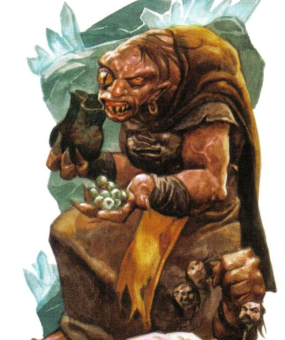
Copyright 2009 Wizards of the Coast Blinders have more specialized and discerning tastes than totemists. They collect eyes instead of lugging whole heads around. Blinders are the scholars and sages of fomorian-kind, acting as repositories of their civilization’s lore. They’re also very good at eye-based magic - if anyone knows how to make a defense against the Evil Eye, it’s them.
Blinders are Level 20 Elite Artillery with 296 HP. They use quarterstaffs for melee combat but their forte is eye magic. Acid Eye is a ranged attack that deals acid and necrotic damage, and whose enervating properties prevent the use of encounter or daily powers for a turn. Shower of Ichor (encounter) deals the same damage over a wider area, and also inflicts ongoing acid and necrotic damage.
The blinder’s actual Evil Eye is quite powerful: it does no damage by itself, but someone cursed by it will take the same damage the fomorian inflicts on other enemies with their other attacks. It ends when the victim saves successfully, or when the fomorian uses this on someone else.
Ironically, blinders have no abilities that actually blind people.
Fomorian Butcher
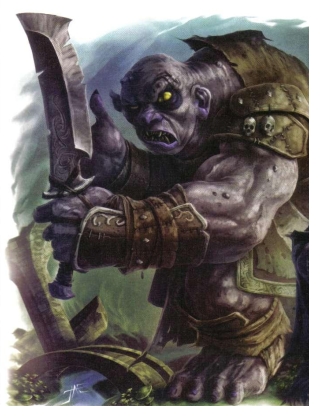
Copyright 2009 Wizards of the Coast Butchers are big fomorians with big blades who like to cut people up for fun. Such simplicity is a bit disappointing after we saw all those esoterically evil fomorian casters and assassins, but they’re still very dangerous and just as ambitious. In fact, they go to absurd lengths to fulfill their serial-killer urges, and will often trade their souls to devils and make other dangerous deals in exchange for more power.
Butchers are Level 22 Elite Brutes with 514 HP. They use titan-sized falchions, which are High-Crit weapons. They’re all about focusing on a single victim and hacking them apart with repeated strikes: when they score a critical, they can make another free attack with the falchion against the same victim, and their attacks deal a bunch of extra damage against a victim they already hit earlier in the same turn. Their Evil Eye restrains (save ends).
There are several ways they can get that extra damage from a “subsequent” hit: the bonus attack from a critical, spending an action point to attack again, and I’d say hitting with the Evil Eye also counts for this. So they’ll always try that before swinging their blades.
Sample Encounters and Final Impressions
Most of the sample encounters here are “Assorted Fomorians” from this book and the MM. One of them also involves drow and Lolthbound Goblins. Generally speaking you can also frequently find fomorians accompanied by cyclops slaves, or by other evil fey they’ve enslaved or allied with. Devils could also make an appearance, since it seems Fomorian diabolists are somewhat common.
This lot is quite a bit more flavorful than the fomorians in the MM, and the extra lore does justice to the basics laid down by the first book. “Voodoo” is a very unfortunate name for an ability, but it’s easy enough to change.
subscribe via RSS